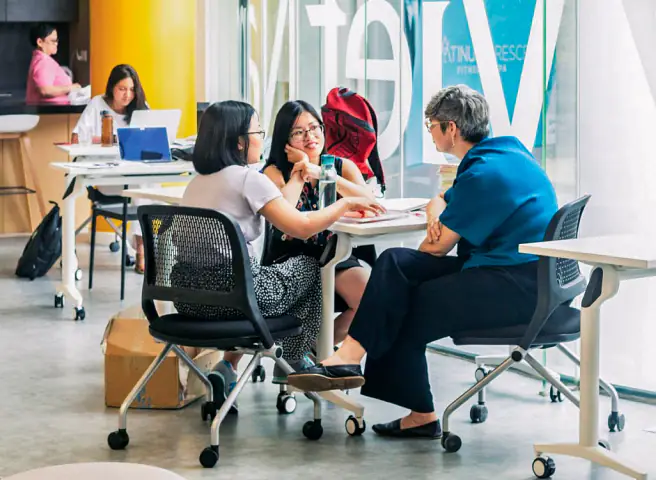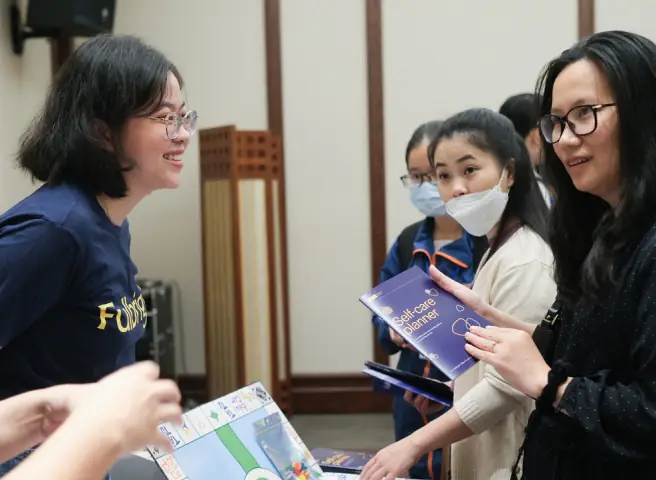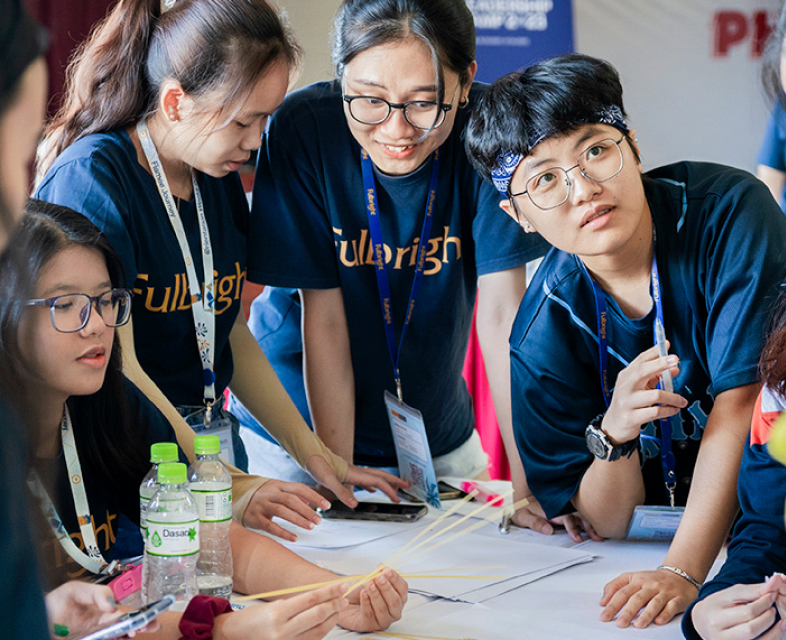
Fulbright University Vietnam recently held an online discussion titled “Beijing’s Expanding Shadow: Choices for Vietnam,” elaborating on the attitudes of Southeast Asian countries towards the rise of China.
The discussion focused on Under Beijing’s Shadow: Southeast Asia’s China Challenge – the latest book by Mr. Murray Hiebert, senior associate of the Southeast Asia Program of the Center for Strategic and International Studies in Washington, DC. Hiebert was joined by two other panelists, Mr. Pham Quang Vinh, former Vietnamese Ambassador to the United States, and Mr. Le Hong Hiep, Fellow at the Vietnam Studies Program and the Regional Strategic and Political Studies Program of the ISEAS-Yusof Ishak Institute.
The panelists focused on the economic and political influence of Beijing on Southeast Asia, and the 10 ASEAN countries’ responses to China’s “carrot and stick” policy, and suggested that countries in the region moderate their policies so they can both maintain their national interests and protect their sovereignty in the face of China’s rise.

From the book cover of “Under Beijing’s Shadow: Southeast Asia’s China Challenge” by Murray Hiebert
To summarize his book, Hiebert said that countries in the region found China’s rise to be both a challenge and an opportunity: the challenge is to maintain their sovereignty, and the opportunity is to benefit from China’s economic rise.
As a reporter working in Southeast Asia for more than 40 years, Hiebert acknowledges that the region “holds a special place in Chinese foreign policy owing to geographical, historical, and economic ties, as well as the migration of millions of ethnic Chinese to the region.”
Dr. Le Hong Hiep praised Hiebert’s 600-page book for providing a detailed, in-depth overview encompassing all 10 members of ASEAN currently dealing with China’s growing influence, setting it apart from other published works on ASEAN-China relations who don’t cover all countries in the region.
“The book analyzes Southeast Asian countries’ reaction to China’s rise and these reactions vary but can be summarized as ‘a cocktail of hope and anxiety,’ as Murray writes, but the level of hope and anxiety in each country varies as each country views and reacts to China’s expanding shadow in different ways,” he said.
From hidden strength to contemporary ascendance

Former Ambassador Phạm Quang Vinh
Former ambassador Pham Quang Vinh emphasized the importance of knowing the shift in China’s foreign policy: from Deng Xiaoping’s famous dictum, “Hide your strength, bide your time,” today’s China is much more assertive towards Southeast Asian countries.
During the online discussion, Hiebert described and discussed the economic, political and military aspects of China’s presence in the region. Generally, an increased economic cooperation on the part of ASEAN countries can provide multiple benefits, in terms of trade, tourism, market access and infrastructure investments, as highlighted by China’s Belt and Road Initiative. “Since the 90s or so, there has been a surge of Chinese immigrants into northern Myanmar and northern Laos where they grow rubber, pumpkins, watermelon and send it back to China,” he noted.
According to Hiebert, China also seeks to enhance its influence through soft power. Notably, China offers scholarships for regional students, has opened 30 Confucian institutes in Southeast Asia, and frequently invites regional high-ranking officials, academics, journalists and religious leaders to visit China. China has also ramped up its military interests through arms sales and joint military exercises with countries in the region.
As Hiebert describes in his book, China has brought economic benefits but also challenges and imminent risks to ASEAN countries. Increased investments for infrastructure projects in less developed countries such as Laos, Cambodia and Myanmar has left these countries mired in debt as they suffer from environmental consequences, substandard projects, corruption, bribery and political dependence.
China’s military aggression is best demonstrated by the disputes still rocking the South China Sea. Since 2013, China has built 7 islands, among which 4 are militarized. In recent years, the Chinese Coast Guard as well as maritime militia vessels continue to harass fishermen and oil and gas facilities operated by regional powers, according to Hiebert.

Murray Hiebert
Another cause for concern, as outlined by Hiebert, is the construction, by China, of 11 dams in the upper reaches of the Mekong River, a major cause of the severe droughts that have affected the Lower Mekong in recent years, in particular in 2019 and 2018.
“An NGO that takes satellite photos of various development projects found that behind just two dams, No. 7 and No.11, China has been holding back enough water this year to fill the whole Chesapeake Bay in Washington,” he said.
Hiebert and other panelists agreed that the Mekong issue is as serious and deserving of attention as the South China Sea disputes. The Mekong Delta holds incredible significance as “Vietnam’s rice bowl”, and has suffered in recent years from extreme droughts that cause severe damage to farming activities. Meanwhile, water and silt remain blocked upstream, drastically altering the water and ground levels of the Lower Mekong to the point of threatening an inflow from the South China Sea and the subsequent salination of farmlands.
All panelists agreed that Southeast Asian countries should mobilize international support, including from China, to deal with the Mekong River issue that pose a serious risk to the environment and sustainability of water resources.
ASEAN countries’ responses
According to Dr. Hiep, Hiebert believes Southeast Asian states exist along a spectrum in regards to their reactions to China’s growing shadow. But 3 groups can be broadly defined. The first group is ‘bandwagoners’, and includes Cambodia, Laos, Brunei and Myanmar. For them, economic development is the top priority. The second group, ‘hard balancers’, composed of Vietnam, Singapore, and Indonesia, and is generally more wary of China’s influence. The remaining countries’ stances combine some aspects of both, or are in-between. The Philippines is described as ambivalent, Thailand as a ‘partial hedger’, and Malaysia as a ‘soft balancer’.
“How can we explain such varied reactions to China’s rise? I think their perception of China is shaped by their own perception of the opportunities offered and risks posed by China,” he claimed.

Dr. Lê Hồng Hiệp (right)
In the Vietnam chapter, Hiebert writes that Vietnam is adopting a hard balancing strategy against China’s rise, mostly by enhancing its military capabilities to deal with the increasing pressure put by China in the South China Sea issue, which is regarded as the biggest threat to Vietnam’s national security and territorial integrity.
China is currently Vietnam’s largest trade partner, and also the largest source of Vietnam’s imports. The two countries’ bilateral trade reached $116.9 billion US dollars last year. China ranks 4th in the list of foreign investors in Vietnam, when including Hong Kong, with about $39 billion US dollars.
In Dr. Hiep’s opinion, Vietnam has good reasons to maintain a peaceful and stable relationship with China; in fact, Vietnam’ s geographical proximity and China’s importance to Vietnam in terms of economy, trade and security, leave few other options.
“I think Vietnam will still continue to maintain a peaceful and stable relationship with China. To this end, Vietnam as well as China will try to isolate the South China Sea dispute from the overall relationship between the two countries,” he commented.
However, Hiep further noted that Vietnam should not fold under China’s bullying behavior in the South China Sea, which constitutes a threat to Vietnam’s sovereignty and its energy and food security. Vietnam will need to continue building economic and military capabilities to attract friends and allies to its side, and diversify bilateral relations with other major powers.
Former ambassador Vinh commented that smaller countries like Vietnam and other ASEAN countries have nowadays developed much more sublte and sophisticated ways to interact with major powers like China; it is not just as simple as a binary choice between China or the United States.
“I do agree that we need to diversify our relations and political, economic and security interests. We need to engage all the players in this region bilaterally and multilaterally, not only the U.S. and China, but Australia, Japan, Korea, India, and many others, under the mechanisms of ASEAN. Diversification, multilateralization, self reliance… are essential policies. ASEAN countries also need to be honest to one another,” he noted.
Thuy Hang







